Songs and Anthems | Legends and Supporters | History of the song
The Celtic Song
As sung on the terraces ![[Untitled] [Untitled]](https://wikifoundryimages.s3.amazonaws.com/ca8f1c7b6d72e3a6c5464d279abaada7)
#Hail Hail, the Celts are here,
What the hell do we care,
What the hell do we care,
Hail Hail, the Celts are here,
What the hell do we care now..
For its a grand old team to play for,
For its a grand old team to see,
And if you know the history,
Its enough to make your heart go,
GO-OH-OH-OH! {or, 9-In-A-Row}
We don’t care what the animals say,
What the hell do we care,
For all we know,
Is that there’s going to be a show,
And the Glasgow Celtic will be there. #
Full Version
#For it’s a grand old team to play for,
For it’s a grand old team be dad,
And when you read it’s history,
It’s enough to make your heart go sad,
God bless them.
We don’t care if we win lose or draw,
Darn the hair do we care,
For we only know that there’s going to be a show,
And the Glasgow Celtic will be there.
Sure it’s the best darn team in Scotland,
And its players all are grand,
We support the Celtic,
As they are the finest in the land
We love them,
We’ll be there to give the Bhoys a cheer
When the league flag flies,
And they cheers us up when we know the Scottish Cup
Is coming home to rest at Paradise.
Sure it’s a grand old team to play for,
Sure it’s a grand old team be dad,
And when you read it’s history,
It’s enough to make your heart go sad,
God bless them.
We don’t care if we win lose or draw,
Darn the hair do we care,
For we only know that there’s going to be a show,
And the Glasgow Celtic will be there,
And the Glasgow Celtic will be there.#
History of the song
The (almost) complete history of Hail Hail and The Celtic Song, with links for your listening pleasure!
It all starts in 1853 with the Opera Il Trovatore (The Troubadour), written by Verdi. In act II, scene 1, the gypsies sing the famous Anvil Chorus
You can watch a performance of the Anvil Chorus below. Pay attention at 0:58 in:
Youtube Link – The Anvil Chorus
Fast forward to 1879. W.S Gilbert and Arthur Sullivan write the comic opera The Pirates of Penzance. They heavily rip off Verdi’s Anvil chorus for the song “With cat-like tread, upon our prey we steal”, which is sung by the pirates at the climax of the show.
You can watch a performance of “With cat-like tread” below:
Youtube Link – With Cat-Like Tread
Pay attention to the chorus at 0:37, the words are:
Come, friends, who plough the sea,
Truce to navigation;
Take another station;
Let’s vary piracee
With a little burglaree!
Come, friends, who plough the sea,
Truce to navigation;
Take another station;
Let’s vary piracee
With a little burglaree!
Now fast forward to 1917. A military marching song is written by D.A. Estron and Theodore Morse called “Hail Hail the gangs all here”, based on “With Cat-like Tread”. The song is first recorded by Irving Kaufman, and becomes a number one hit in 1918.
Click below to listen to “Hail Hail the gangs all here” as sung by Kaufman in 1917.
Archive.org link – Hail Hail the gangs all here
Sounds familiar doesn’t it?
The lyrics to the chorus are:
Hail! Hail! the gang’s all here,
What the deuce do we care,
What the deuce do we care,
Hail! Hail! we’re full of cheer,
What the deuce do we care Bill!
After this, at some point prior to the 1960’s the song is sung on the Parkhead Terraces as:
Hail Hail, the Celts are here,
What the hell do we care,
What the hell do we care,
Hail Hail, the Celts are here,
What the hell do we care now…
Then, in 1961, “Mr Glasgow” Glen Daly records a completely unrelated song called “The Celtic Song”. The music is credited as “traditional” and the lyrics are credited to “Liam Mallory”. However, nobody seems to know who Liam Mallory is, and it has been suggested that it is actually a pseudonym for Glen Daly himself!
It is also suggested however, that the song was written by a man called Mick McLaughlin, known as “Garngad Mick”, who allegedly also wrote “Hampden in the Sun”. The story goes that he sold the rights to the the Celtic Song to Glen Daly for a fiver!
Click below to download the famous Glen Daly version of The Celtic Song:
Megaupload Link – The Celtic Song
The Celtic Song lyrics
Glen Daly also released a song called “Hail Hail Celtic” which is another completely original song, obviously inspired by the common “Hail Hail the Celts are Here” terrace chant. It bears some resemblance to Irving Kaufman song above.
Click below to download Glen Daly singing “Hail Hail Celtic”.
MegaUpload Link – Hail Hail Celtic
So today, when the Celtic fans sing “hail hail the celts are here” followed by “its a grand old team…”, we are singing two different songs, of which you now know the (almost) complete history!
History written by KDS Poster chris1983
Notes
- Supposed to have first airing on 25th September at Celtic Park but someon forgot the record: 1961-09-25: Celtic 4-1 Queen’s Park, Glasgow Cup
- First airing was: 1961-10-14: Celtic 5-0 Stirling Albion, League Division 1
- Crazy as it might seem to Celtic fans today but the rousing yet harmless anthem known as The Celtic Song was once the cause of much concern in Scotland. Amazingly this simple football song was initially viewed as being potentially inflammatory by sections of the establishment and the press.
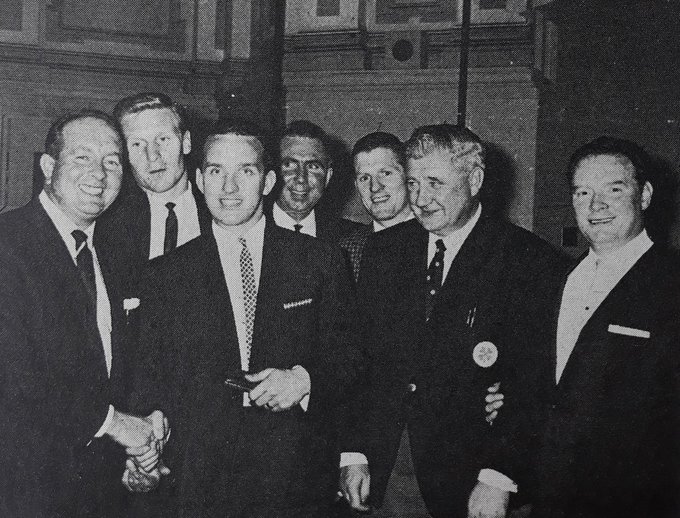
Links
Articles
Belfast Celtic’s Minstrel Bhoy and the Roots of the Celtic Song
Source: http://www.belfastceltic.org/celticsong.html
Thousands of Celtic fans sing The Celtic Song every week at football matches or in bars, clubs, schools and factories from Turf Lodge to Timbuktu! But if you asked them, how many of the green and white choristers would know the history of the song and realize that it actually originated in Belfast? As the Belfast Celtic Museum prepares to open again on St Patrick’s Day, Terry Dick, son of the famous Scottish musical impresario Glen Daly, who made the song famous, gives full credit to Charlie Tully, Belfast’s Minstrel Bhoy!
Glasgow’s immediate post-war years were bleak, with rationing still in force, but Charlie Tully brought much needed smiles and laughter to the city sporting scene.
Soon he had an adoring entourage to rival anything the High Kings had at the Hill of Tara!
On his arrival in Glasgow, Celtic billeted Charlie in the old Kenilworth Hotel in Queen Street and for years afterwards it became a favourite haunt for Celtic players and football personalities.
The Belfast Bhoy held court with wisecracks about the game and its personalities, tales of Belfast and clashes between Linfield and the great Belfast Celtic.
All this was hungry, thirsty work and the ever generous Celt insisted that the not inconsiderable food and drink bill, being run up by his pals, should go on the club’s account! However, if Charlie was in a particularly mischievous mood, he would decide to charge it to his team mate Jock Weir’s bill!
When the stories were exhausted and the customary sing-song started, Charlie would invariably sing the praises of his beloved Belfast Celts with; “Sure it’s a grand old team to play for.”
A version of only a few choruses perhaps, but Glen Daly recalled it years later, when he recorded his own ‘Celtic Song’.
In London in August 1961, at Simpson’s in The Strand, the historic restaurant first opened in 1828, Daly had just finished what was reputed to be the best roast dinner in England. Famous guests of the exquisite London restaurant had included Vincent Van Gogh, Charles Dickens, George Bernard Shaw, Benjamin Disraeli and William Gladstone, but as the diners on that late summer’s night began to drift away, Daly stared intently at his menu, hoping for inspiration.
He was due back in Pye Record’s Marble Arch Studios in one hour to record The Celtic Song, but the final version of his second verse had yet to be completed. He stared intently at the menu and tried to think of where he’d first heard the song. Of course! The Clown Prince of Paradise and good pal, Charles Patrick Tully, had obliged the company one night in the Kenilworth. He smiled as he recalled the magical Irishman and his soft brogue as he sang:
We don’t care if we win, lose or draw;
Darn the hare we care.
Because we only know
That there’s going to be a show
And the Belfast Celtic will be there!

At the Celtic Supporters Association Rally in November 1959, over three thousand fans gathered in Glasgow’s magnificent St. Andrew’s Halls to bid a fond farewell to Charlie on the occasion of his retirement from the Scottish game and his return to St Patrick’s sod.
On stage, Glen Daly recounted every Tully story and joke, as Celtic Chairman Robert Kelly smiled knowingly and in an emotional finale the crowd sang another chorus; “Will ye no come back again?” and cheered the auld yin to the echo!
The programme notes for the evening eloquently conveyed the place Tully held in Celtic hearts.
They read; “Tonight, we pay tribute to Charlie on his retirement from the Scottish football scene and wish him all the best in his new capacity as player-manager at Cork Hibs. Charlie gave all of us many happy hours by his football wizardry and his Tullyisms. It is players of Tully’s greatness that have helped make Celtic great!”
Almost two decades on from his Kenilworth Hotel days, on May 25 1967, as he was leaving the Estadio Nacional in Lisbon, in the hot midst of Celtic’s finest hour, Charlie was mobbed by celebrating fans that still accorded him legendary status.
When asked where he could have played in the team that had just become European Champions, the sparkling wit of Tully was in evidence once more, as he replied; “Sure I could have taken the corners!”.
But Charlie was being uncharacteristically modest on this occasion, for surely he could have added his soft Irish brogue to Bertie Auld’s inspirational chorus of The Celtic Song in the stadium tunnel.
After all, it was the song he’d brought all those years ago from the Donegall Road in Belfast, which has become one of the club’s great pre-match anthems, welcoming Celtic sides onto the pitch for the last 50 years.
Enshrined in song and story, the fame and memory of Charlie Tully remain evergreen – in the pantheon of Celtic Greats, he commands a unique prominence and affection. Stellar personality, wit and raconteur, supreme entertainer – the darlin’ minstrel bhoy of the Celtic faithful had it all!
From the Celtic View (22 Jan 1992)

26 September 1961
Mystery Solved, exactly 60 Years after The Celtic Song is first played at Paradise
Mystery Solved, exactly 60 Years after The Celtic Song is first played at Paradise
By Editor 14 October, 2021
No Comments
Sixty Years after The Celtic Song is first played at Paradise, Will the real Liam Mallory Stand Up?
Sixty years ago, on 14 October 1961 Celtic defeated Stirling Albion at Celtic Park by five goals to nil. The goals were scored by Bobby Carroll, a hat-trick from John ‘Yogi’ Hughes and a late strike by John Divers Jnr. A crowd of 22,000 were at Celtic Park to see these goals being scored and they also got to hear for The Celtic Song by Glen Daly played over the tannoy for the first time ever…
And there’s a mystery surrounding The Celtic Song that Jamie Fox can clear up for us today….
Will the real Liam Mallory Stand Up?
“They seek him here, they seek him there
Those Frenchies seek him everywhere
Is he in heaven or is he in hell?
That demned elusive Pimpernel”
On both the Celtic Song and John Thomson Song ‘new lyrics’ are credited to Liam Mallory. However, the words of these Celtic classics didn’t come from the pen of this mysterious and subsequently elusive character.
The lyrics of the John Thomson Song were roughly contemporary with the Celtic goalkeeper’s tragic death at Ibrox, while the Celtic Song had come, via the Donegall Road home of Belfast Celtic, to Glasgow at about the same time as the arrival of the ‘Clown Prince of Parkhead’ Charlie Tully in 1949.
The real identity of Liam Mallory was in fact Clifford P. Stanton, who was the proprietor of a Parkhead record shop and another music business on the Gallowgate opposite Barrowland. Glasgow Jazz Promotions, at 271 Gallowgate, was a typical 50’s/60’s record shop with the emphasis on Jazz and Blues recordings, U.S. imports and sheet music.
Cliff, a Londoner, recording manager, music publisher, promoter and talent scout was one of the shrewdest and most likeable people in the music industry. He represented prominent Folk Artistes such as Hamish Imlach and Josh McCrea, promoted ‘Riverboat Shuffles’ on the Clyde, successful Jazz concerts in St Andrew’s Halls and authored a column in ‘Record Mirror’. He was certainly influential in the industry, even securing the services of music legend Tony Hatch as producer on Buddy Logan’s ‘The Rangers Song’ (1961) another of Clifford’s projects.
Stanton was responsible for giving Glen Daly the opportunity to record the Celtic Song and John Thomson Song which were originally intended for the Beltona label. However, as a result of impressive, record-breaking pre-release orders, both songs were finally issued on the more prestigious PYE Piccadilly label.
Although an experienced Variety Artiste, Glen Daly was very much an ‘innocent abroad’ in the world of recording and music publishing. He didn’t realise, for example, that if no one claimed the rights to lyrics or music that they could be quite legitimately claimed by anyone who wanted to exploit them commercially. Realising the sales potential of both songs, Cliff Stanton claimed the rights and consequently his ‘nom de plume’ Liam Mallory appears on both the discs and sheet music as the lyricist.
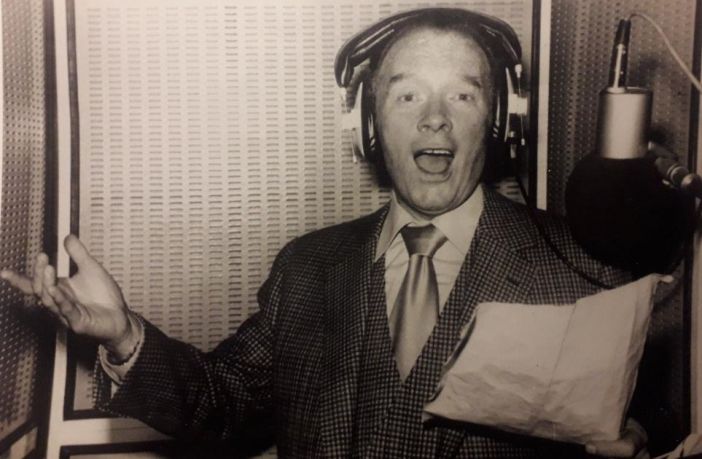
Glen Daly, who in fact wrote the second verse in Simpson’s on the Strand on the afternoon before the recording session at PYE’s Marble Arch Studios, was quite content with this arrangement. He was excited at the prospect of a recording career and even more importantly the royalties of one ‘old’ penny for each disc sold and a significant share in the profits from sheet music sales.
Why didn’t Stanton use his own name?
Both songs were published by Clifford Music but perhaps the Londoner had some financial consideration in mind (HMRC?) or did the name Liam suggest an extremely commercial hint of the Emerald Isle? Cliff Stanton had no real interest in football, and would reluctantly declare himself an Arsenal fan, but he saw clearly and earlier than most the commercial and promotional opportunities that the game and the major clubs offered.
The layout of his Gallowgate shop reflected his retail philosophy. One window devoted to Celtic recordings and one to the other half of the Old Firm. His anonymity would have been guaranteed except for a promotional picture that appeared in the Irish Weekly (1962) where he is featured alongside Glen Daly promoting sheet music and clearly identified as: ‘Liam Mallory of the publishers Clifford Music’.
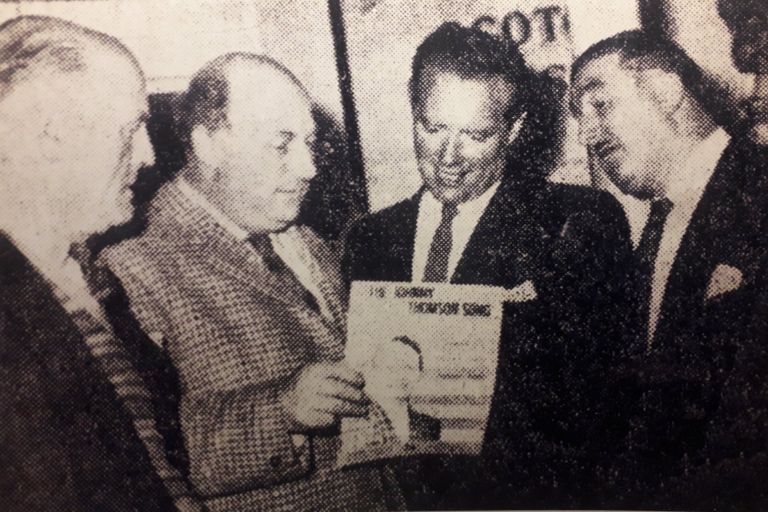
Cliff’s contribution to Celtic musical tradition continued in 1964 with the release on the Beltona label of the ‘Parkhead March Medley’ performed by the quaintly named ‘Parkhead Enthusiasts’. The tracks included re-recordings of the Celtic Song and John Thomson Song as well as other Irish favourites.
In 1966, on the Pan label, a collection called ‘Celtic Supporters Songs’ included musical content that sounded vaguely and disturbingly familiar. Stanton (AKA Mallory) with his co-writer Hogan McComish claimed to be the composer of some ‘new’ titles: ‘Follow, Follow Celtic’, ‘The Flag My Father Bore’, ‘There’s Not a Team’ and ‘Long Live Celtic’. In an ecumenical gesture, although a committed Marxist from a Jewish background, on the B Side Cliff claimed composition of ‘Hail Glorious St Patrick’, ‘Faith of our Fathers’ as well as a number of traditional Irish patriotic songs.
Now where does all this leave the alleged involvement of prominent and much revered Garngad poet Mick McLaughlin who we are often told sold The Celtic Song, based on the overture to the Pirates of Penzance, to Glen Daly for £5?
The overture does of course clearly inspire the traditional and much beloved ‘Hail! Hail!’. However, examination of the sheet music shows that nothing in Glen Daly’s Celtic Song corresponds, or is even vaguely similar, to the Gilbert and Sullivan work. Mick’s cultural contribution to his community was certainly substantial and invaluable but unfortunately The Celtic Song cannot be included credibly in any anthology of his work.
There was however in 1961 a threat of legal action, for infringement of copyright, by the copyright holders of the hit musical ‘The Music Man’ (1957/Wilson) claiming that ‘Seventy-Six Trombones’ had been copied by the Celtic Song. Fortunately, no legal action was forthcoming. Finally, Glen Daly only learned that he was to record The Celtic Song during a break in a White Heather Club tour which allowed him to meet up with Clifford Stanton in Glasgow, where he signed a record contract beginning a long association with PYE Records.
Lord Lucan, Amelia Earhart, Jimmy Hoffa, Glenn Miller. All still a mystery – but at least now the elusive Liam Mallory has been identified.
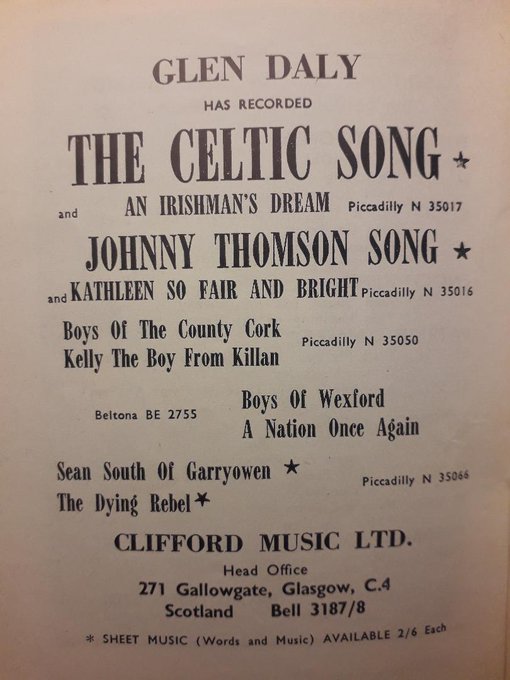
The ‘inflammatory’, ‘potentially offensive’ Celtic Song
By Editor 14 October, 2022 1 Comment
In a week when another Celtic song is under attack from the mainstream media it’s worth remembering that this is nothing new…
Sixty One Years after The Celtic Song is first played at Paradise, Will the real Liam Mallory Stand Up?
Sixty one years ago, on 14 October 1961 Celtic defeated Stirling Albion at Celtic Park by five goals to nil. The goals were scored by Bobby Carroll, a hat-trick from John ‘Yogi’ Hughes and a late strike by John Divers Jnr. A crowd of 22,000 were at Celtic Park to see these goals being scored and they also got to hear for The Celtic Song by Glen Daly played over the tannoy for the first time ever…
And there’s a mystery surrounding The Celtic Song that Jamie Fox can clear up for us today….
Will the real Liam Mallory Stand Up?
“They seek him here, they seek him there
Those Frenchies seek him everywhere
Is he in heaven or is he in hell?
That demned elusive Pimpernel”
On both the Celtic Song and John Thomson Song ‘new lyrics’ are credited to Liam Mallory. However, the words of these Celtic classics didn’t come from the pen of this mysterious and subsequently elusive character.
The lyrics of the John Thomson Song were roughly contemporary with the Celtic goalkeeper’s tragic death at Ibrox, while the Celtic Song had come, via the Donegall Road home of Belfast Celtic, to Glasgow at about the same time as the arrival of the ‘Clown Prince of Parkhead’ Charlie Tully in 1949.
14th October 1961, Glen Daly’s The Celtic Song was played at Celtic Park for the first time before a 5:0 victory over Stirling Albion.https://t.co/uwGBqRYJmN
Excellent rendition of it from 1998. pic.twitter.com/hRFoMFEMBt
— Li’l Ze (@LilZe_7) October 13, 2022
The real identity of Liam Mallory was in fact Clifford P. Stanton, who was the proprietor of a Parkhead record shop and another music business on the Gallowgate opposite Barrowland. Glasgow Jazz Promotions, at 271 Gallowgate, was a typical 50’s/60’s record shop with the emphasis on Jazz and Blues recordings, U.S. imports and sheet music.
Cliff, a Londoner, recording manager, music publisher, promoter and talent scout was one of the shrewdest and most likeable people in the music industry. He represented prominent Folk Artistes such as Hamish Imlach and Josh McCrea, promoted ‘Riverboat Shuffles’ on the Clyde, successful Jazz concerts in St Andrew’s Halls and authored a column in ‘Record Mirror’. He was certainly influential in the industry, even securing the services of music legend Tony Hatch as producer on Buddy Logan’s ‘The Rangers Song’ (1961) another of Clifford’s projects.
Stanton was responsible for giving Glen Daly the opportunity to record the Celtic Song and John Thomson Song which were originally intended for the Beltona label. However, as a result of impressive, record-breaking pre-release orders, both songs were finally issued on the more prestigious PYE Piccadilly label.
The Celtic Song controversy https://t.co/54uK97m8WG pic.twitter.com/Pv47CrUNTU
— Celtic Wiki (@TheCelticWiki) October 14, 2022
Although an experienced Variety Artiste, Glen Daly was very much an ‘innocent abroad’ in the world of recording and music publishing. He didn’t realise, for example, that if no one claimed the rights to lyrics or music that they could be quite legitimately claimed by anyone who wanted to exploit them commercially. Realising the sales potential of both songs, Cliff Stanton claimed the rights and consequently his ‘nom de plume’ Liam Mallory appears on both the discs and sheet music as the lyricist.
Glen Daly in the recording studio
Glen Daly, who in fact wrote the second verse in Simpson’s on the Strand on the afternoon before the recording session at PYE’s Marble Arch Studios, was quite content with this arrangement. He was excited at the prospect of a recording career and even more importantly the royalties of one ‘old’ penny for each disc sold and a significant share in the profits from sheet music sales.
Why didn’t Stanton use his own name?
Both songs were published by Clifford Music but perhaps the Londoner had some financial consideration in mind (HMRC?) or did the name Liam suggest an extremely commercial hint of the Emerald Isle? Cliff Stanton had no real interest in football, and would reluctantly declare himself an Arsenal fan, but he saw clearly and earlier than most the commercial and promotional opportunities that the game and the major clubs offered.
The layout of his Gallowgate shop reflected his retail philosophy. One window devoted to Celtic recordings and one to the other half of the Old Firm. His anonymity would have been guaranteed except for a promotional picture that appeared in the Irish Weekly (1962) where he is featured alongside Glen Daly promoting sheet music and clearly identified as: ‘Liam Mallory of the publishers Clifford Music’.
The only known pic of him – Stanton/Mallory is holding the sheet music.
Cliff’s contribution to Celtic musical tradition continued in 1964 with the release on the Beltona label of the ‘Parkhead March Medley’ performed by the quaintly named ‘Parkhead Enthusiasts’. The tracks included re-recordings of the Celtic Song and John Thomson Song as well as other Irish favourites.
In 1966, on the Pan label, a collection called ‘Celtic Supporters Songs’ included musical content that sounded vaguely and disturbingly familiar. Stanton (AKA Mallory) with his co-writer Hogan McComish claimed to be the composer of some ‘new’ titles: ‘Follow, Follow Celtic’, ‘The Flag My Father Bore’, ‘There’s Not a Team’ and ‘Long Live Celtic’. In an ecumenical gesture, although a committed Marxist from a Jewish background, on the B Side Cliff claimed composition of ‘Hail Glorious St Patrick’, ‘Faith of our Fathers’ as well as a number of traditional Irish patriotic songs.
Morning all, on this day in 1961 the Celtic Song by Glen Daly was first played over the scratchy old PA system at Celtic Park and was instantly popular. 61 years later the song is still sung by fans of Celtic and indeed other clubs, most notably Everton. pic.twitter.com/TYG1e0OR1j
— Lisbon Lion (@tirnaog_09) October 14, 2022
Now where does all this leave the alleged involvement of prominent and much revered Garngad poet Mick McLaughlin who we are often told sold The Celtic Song, based on the overture to the Pirates of Penzance, to Glen Daly for £5?
The overture does of course clearly inspire the traditional and much beloved ‘Hail! Hail!’. However, examination of the sheet music shows that nothing in Glen Daly’s Celtic Song corresponds, or is even vaguely similar, to the Gilbert and Sullivan work. Mick’s cultural contribution to his community was certainly substantial and invaluable but unfortunately The Celtic Song cannot be included credibly in any anthology of his work.
There was however in 1961 a threat of legal action, for infringement of copyright, by the copyright holders of the hit musical ‘The Music Man’ (1957/Wilson) claiming that ‘Seventy-Six Trombones’ had been copied by the Celtic Song. Fortunately, no legal action was forthcoming. Finally, Glen Daly only learned that he was to record The Celtic Song during a break in a White Heather Club tour which allowed him to meet up with Clifford Stanton in Glasgow, where he signed a record contract beginning a long association with PYE Records.
Lord Lucan, Amelia Earhart, Jimmy Hoffa, Glenn Miller. All still a mystery – but at least now the elusive Liam Mallory has been identified.
Some background to The Celtic Song worth recounting…
Celtic Songs – Video: The Celtic Song & Hail Hail The Celts Are Here
Picture the scene: Celtic on the cusp of glory. By hook, crook, bus, plane, train and automobile, thousands of supporters had made it to Lisbon for the final of the 1967 European Cup. The faithful had won the hearts of the Portuguese people with their exemplary conduct and incredible atmosphere before the match. As the Celtic players lined up alongside their Italian opponents in the tunnel, Bertie Auld cleared his throat and began to sing: “Sure it’s a grand old team to play for…”
Each of the Lisbon Lions joined in and Glen Daly’s immortal anthem was soon heard by the supporters. The support sang with the players as the team came into view: “Sure it’s a grand old team to see and if you know the history…” The enjoyment of the occasion by players and fans, in unison, appeared to mesmerise the Inter Milan outfit and gave Celtic the upper hand. That moment is regaled as one of the most iconic in the history of Celtic Football Club.
Throughout the years, supporters have enjoyed singing The Celtic Song at many other great times. It is synonymous with the club. A vocal monument to Celtic. However, it is an often-overlooked fact that fans are actually singing a combination of two different songs on the terraces – Hail Hail The Celts Are Here and The Celtic Song. The latter is played on its own over the speakers at Celtic Park before every home match, as the teams emerge from the tunnel.
Glen Daly eventually produced the iconic Celtic Song at Pye Record’s Marble Arch Studios in London, in August 1961. On his visit to record the immutable track, he had an hour to kill and reportedly went for a roast dinner in The Strand restaurant, which was among the most reputable in the city and boasted a guest list that was littered with celebrity names. Upon devouring the meal, the Calton born artist is said to have pondered over the second verse of The Celtic Song, which he felt was inadequate.
It was at the restaurant table that a desperate Daly became inspired, when he recalled the voice of Belfast Celtic fanatic, Charlie Tully, who had sung the Antrim club’s classic song at a party in Kenilworth one evening. The lyrics that Glen Daly remembered hearing Tully slur were part of a short ditty that had been a favourite of Belfast Celtic’s support for years: ‘We don’t care if the money’s right or wrong. Darn the hare we care because we only know that there’s going to be a show and the Belfast Celtic will be there.’ The words were a perfect fit. Glen Daly’s anthem was complete, and the song was released on a 45rpm single record in October 1961.
Glen Daly leads the sing song ☘️☘️ pic.twitter.com/ahJtnlRVny
— Willie Collow (@CollowWillie) October 8, 2022
Much like the attachment of This Land Is Your Land to Let The People Sing, Hail Hail The Celts Are Here was connected to The Celtic Song by Hoops supporters in the early 1960s.
Hail Hail The Celts Are Here can be traced back to a 1917 military marching song by D.A. Estron and Theodore Morse, called Hail Hail The Gangs Are Here. It was set to the tune of With Cat-like Tread, Upon Our Prey We Steal, which was a song featured in an 1879 Gilbert & Sullivan opera, named The Pirates of Penzance. The song had been largely plagiarised by Gilbert and Sullivan, who stole the original version, entitled The Anvil Chorus, from Italian opera composer – Giuseppe Verdi. Verdi had written The Anvil Chorus for an 1853 opera: Il Trovatore (The Troubadour), which in turn was based on the play, El Trovador, written by Antonio García Gutiérrez in 1836!
The lyrics to the 1917 adaption, from which the Celtic chant arose, can be heard in the video below:
A swift modification to make the version appropriate for Celtic Football Club was made and the song was then used on the terraces as a preamble to The Celtic Song.
As is aforementioned, The Celtic Song, as a standalone match day anthem, holds a historic and enduring place in Celtic folklore. It was first played over the tannoy at Celtic Park on 14 October 1961, prior to a league match against Stirling Albion. However, following its release, it was immediately under threat from the establishment. The media reported on the song in a very peculiar manner, instantly describing it as ‘inflammatory’, ‘potentially offensive’ and ‘a possible catalyst for old firm trouble’. The Daily Mail even ran a story in October 1961 with the headline: ‘Police Condemn New Celtic Rallying Song’. The piece went on to say:
Glasgow police attacked yesterday, an Englishman’s plan to give Celtic supporters two rallying songs. One of the songs – both have already been recorded – tells of the death of Celtic and Scotland goalkeeper John Thomson, who died 30 years ago. The recording company and who organised the recording session is C.P Stanton who runs Glasgow Jazz Club Promotions Ltd.
“It is ridiculous to suggest these records could cause more trouble,” he said last night.
Common sense eventually prevailed, and The Celtic Song lived on as the soundtrack to the Bhoys becoming champions of Europe six years later. It continues to have an impact, and for that Celtic fans owe a debt of gratitude to the elusive Liam Mallory, and Glen Daly, unless of course they are indeed the same person.
Gerard Farrell @gerrytastic · Nov 2 I ask as these @bfcdublin souvenirs from 1925 were shared with me by @JohnBaitson Fascinating that sharing/copying/adaptation of terrace chants was already so commonplace by the 20s. The original song “Hail Hail the gang’s all here” was only released in 1917.
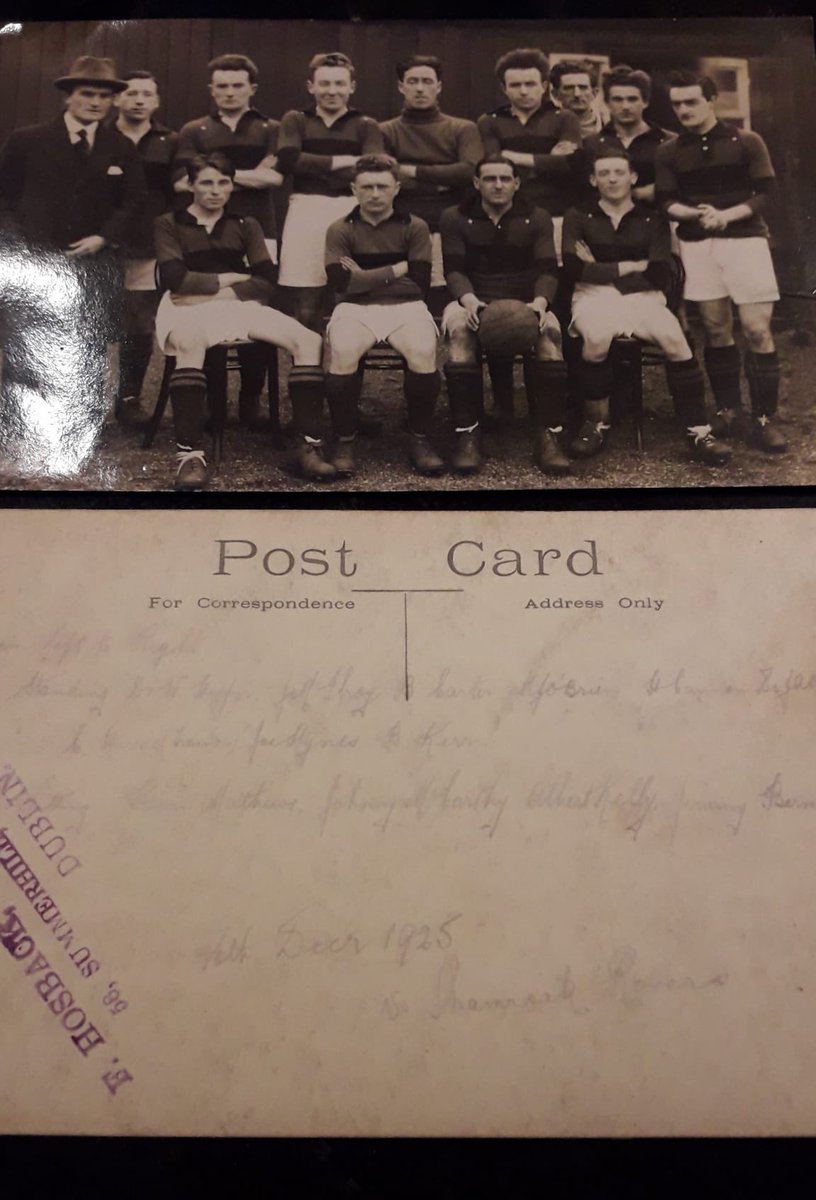
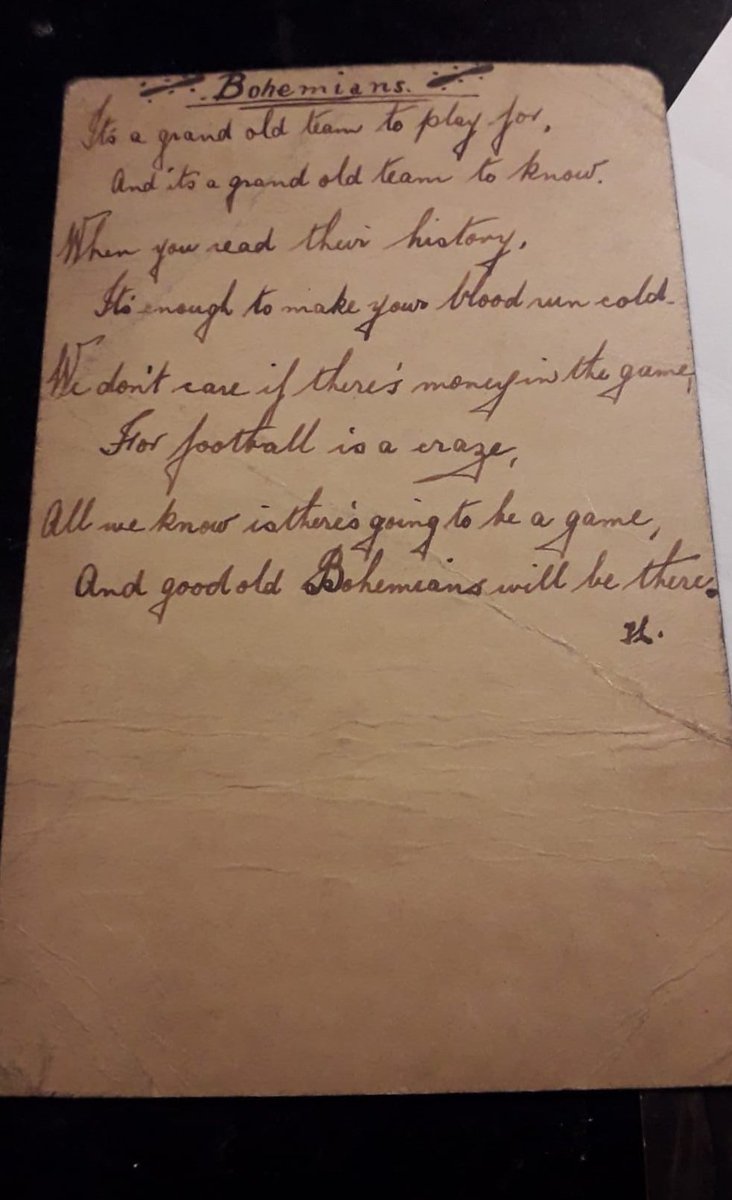
T H E ~ S H A M R O C K @TheShamrock1888The Celtic Song was written by Glen Daly but based on a song sung by Belfast Celtic supporters as taught to him by Charlie Tully. The document above suggests the song was popular among fans in Ireland for some decades before GD’s version was committed to vinyl. Great find
Gerard Farrell @gerrytastic · Nov 3 Replying to @TheShamrock1888 @joebloggscity and 3 others A quick newspaper search on my lunch break brought up this from the Belfast Newsletter in 1966. Earlier I’ve found reference to it being sang at matches in Monaghan & Tyrone & by Sligo Rovers fans in the 1930s & even by the Louth GAA team at the 1950 All Ireland final.
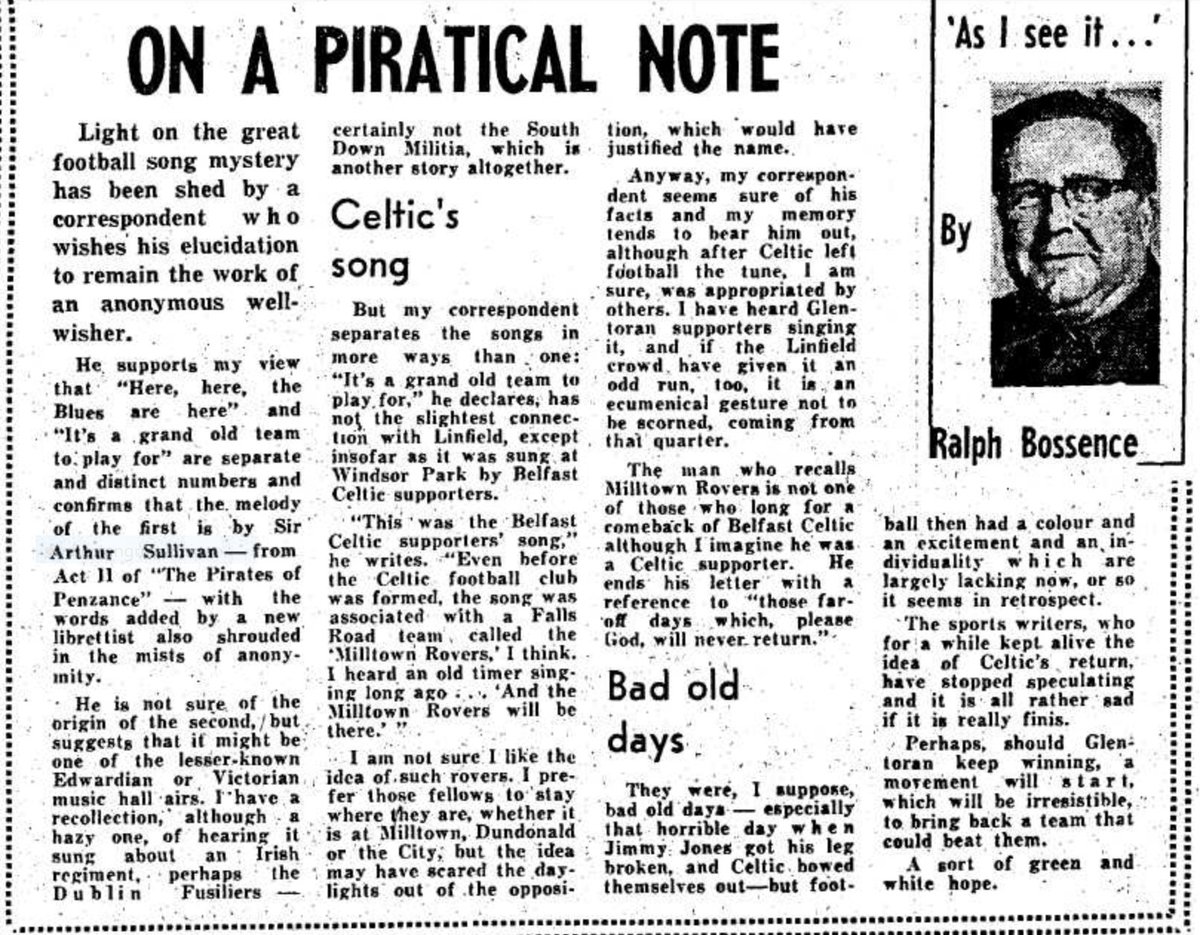
belfast_celtic · We have a Belfast Celtic Programme from 1927 which calls it ‘The Old Song’. We believe the Belfast Celtic version dates from around 1907 as there are hints in the original words, ie references to ‘money’ ie disputes with the IFA over lucrative international matches. These disputes centered around favouritism of Linfield for international games culminating with every club – except Linfield – resigning from the Irish League & forming the gold cup in 1912 – which Celtic won – its now in the Oval as Glentoran were last winners in early 1990’s. The Milltown connection could be sound as they were one of the amalgamated clubs that formed Belfast Celtic. However we’ve been told it was adopted from a British Army marching band which playe
This is the panel in our museum which references the song, with lyrics from 1927.
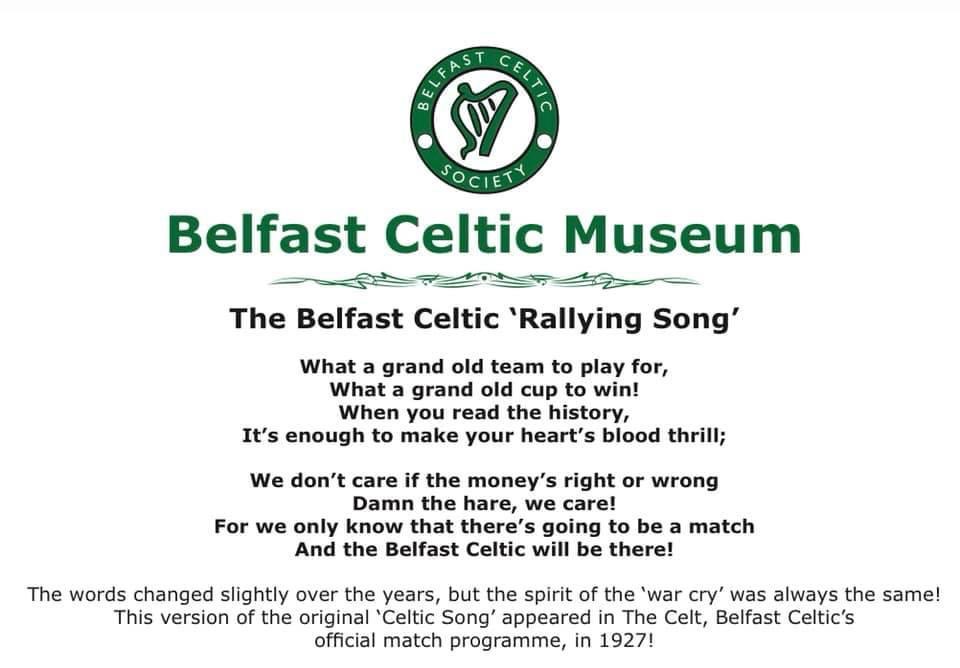
And finally…. ‘Hail Hail the Celts are here’ is a completely different song. Glen Daly sang them both.
Hail Hail
Grand Old Team
Some more here: belfastceltic.org/celticsong.html


